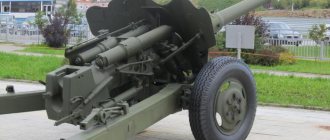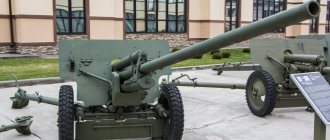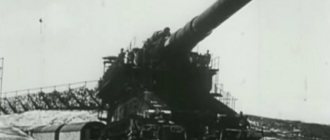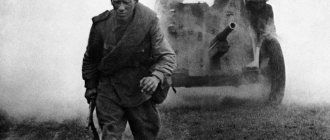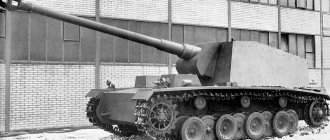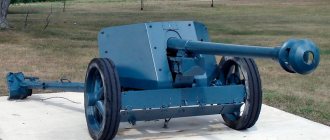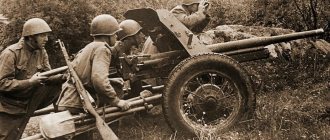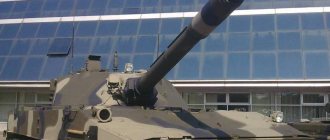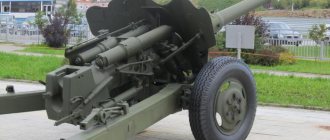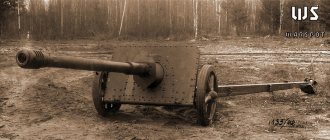The Second World War demonstrated that the development of anti-tank artillery was reaching a dead end. The protection of tanks increased so much that light and mobile guns of relatively small caliber soon turned into bulky systems with a caliber of over 100 mm.
However, for the first time after the war, the development of anti-tank guns did not stop - before the advent of guided missiles, there was simply no other means of combating armored vehicles. One of the first post-war guns was the Soviet D-48 cannon of 85 mm caliber. Its development was led by the famous designer Fyodor Petrov.
Anti-tank gun D-48 - “a weapon with limited capabilities”
The Second World War demonstrated that the development of anti-tank artillery was reaching a dead end.
The protection of tanks increased so much that light and mobile guns of relatively small caliber soon turned into bulky systems with a caliber of over 100 mm. However, for the first time after the war, the development of anti-tank guns did not stop - before the advent of guided missiles, there was simply no other means of combating armored vehicles. One of the first post-war guns was the Soviet D-48 cannon of 85 mm caliber. Its development was led by the famous designer Fyodor Petrov.
At the end of August, People's Commissar of Tank Building V.A. Malyshev, Head of GBTU Marshal of Armored Forces Y.N. Fedorenko and senior officials of the People's Commissariat of Armaments arrived at Tank Plant No. 112. At a meeting with plant managers, Malyshev said that victory in the Battle of Kursk came at a high price. Enemy tanks fired at ours from a distance of 1,500 m, while our 76-mm tank guns could hit “Tigers” and “Panthers” at a distance of 500-600 m. “Figuratively speaking,” said the People’s Commissar, “the enemy has arms one and a half kilometers long, and we are only half a kilometer away. It is necessary to immediately install a more powerful gun in the T-34.”
Around the same time, a similar task regarding heavy KV tanks was assigned to the ChKZ designers.
The development of tank guns with a caliber above 76 mm, as we have already said, began in 1940. In 1942-1943, the teams of V.G. Grabin and F.F. Petrov worked on this.
Since June 1943, Petrov presented his D-5 gun, and Grabin S-53, the leading designers of which were T.I. Sergeev and G.I. Shabarov. In addition, guns of the same caliber were presented for joint testing: S-50 by V.D. Meshchaninov, A.M. Volgevsky and V.A. Tyurin and LB-1 by A.I. Savin. The S-53 gun was selected, but it failed the final tests. The S-53 gun used design solutions for the F-30 gun designed before the war for the future KV-3 heavy tank. The D-5 cannon has proven its advantages over the S-53. But its installation in the tank also required major modifications. In the meantime, it was decided to install it under the brand name D-5S in the new self-propelled unit SU-85, the production of which began at UZTM in August 1943. At plant No. 183 they developed a new turret with a widened shoulder strap with a diameter of 1600 mm instead of the previous 1420. According to the first version of work were led by designers under the leadership of V.V. Krylov, in the second - led by A.A. Moloshtanov and M.A. Nabutovsky. Moloshtanov's group was offered a new 85-mm S-53 cannon. However, its installation would require major changes in the design of the turret and even the hull. This was considered inappropriate.
The first version of the T-34 with the 85 mm D-5T cannon
T-34 produced in 1944 with an 85-mm D-5T cannon
The photo shows a view of the D-5T cannon
Belarus, 1944. This vehicle is equipped with a commander's cupola with a double-leaf hatch, which is typical for both T-34 tanks with the D-5T cannon, and for early production vehicles with the ZIS-S-53 cannon.
In the summer of 1943, the T-34 with a new gun installed in the standard turret was tested at the Gorokhovets training ground near Gorky. The results were unsatisfactory. Two men in the turret could not successfully operate the gun. Ammunition load has been significantly reduced. In order to speed up the process of linking the gun, on the initiative of V.A. Malyshev, Nabutovsky’s group was sent to the TsAKB in October 1943. Nabutovsky came to Malyshev, and he ordered to organize a branch of the Morozov Design Bureau at the artillery plant at which the Grabin TsAKB worked. The joint work with Grabin did not last long. It turned out that the S-53 gun would require a larger turret and a wider shoulder strap.
Then Nabutovsky went to F.F. Petrov. Together they came to the conclusion that his gun needed the same turret modification as Grabin's gun. At a meeting that took place soon, with the participation of the People's Commissar of Armaments D.F. Ustinov, V.G. Grabin, F.F. Petrov, it was decided to conduct comparative tests of both guns. Based on the test results, both artillery design bureaus created a new ZIS-S-53 gun, in which the shortcomings of the “ancestral” systems were eliminated. The gun was tested and showed excellent results (note that the work on creating a new gun took only one month). But the turret was not prepared for this gun. Krylov's group at plant No. 112 designed a cast turret with a 1600 mm shoulder strap for the S-53 cannon. However, the reservation group, led by A. Okunev, determined that the vertical aiming angle of the gun in the new turret was limited. It was necessary to either change the design of the turret or take a different gun.
During the tests of the T-34 with the 85-mm ZIS-S-53
cannon
, Grabin, an ambitious and impatient man, decided to “pull the nose” of the tankers, getting ahead of them. To do this, he ensured that Plant No. 112 allocated him one of the serial T-34 tanks, on which they remade the front part of the turret and somehow shoved a new gun into it. Without hesitation, Grabin handed over his project to D.F. Ustinov and V.A. Malyshev for approval, according to which plant No. 112 was to begin producing prototypes of the modernized tank. However, many specialists from the Scientific Tank Committee (STC) and the People's Commissariat of Armaments legitimately doubted the merits of the “Grabin project.” Malyshev urgently ordered Nabutovsky and his group to fly to plant No. 112 and look into this matter. And so Nabutovsky, at a special meeting in the presence of D.F. Ustinov, Y.N. Fedorenko and V.G. Grabin, subjected the latter’s idea to devastating criticism. “Of course,” he notes, “it would be very tempting to put a new gun in a tank without significant modifications. This solution is simple, but absolutely unacceptable for the reason that with this installation of the gun, its fastening will turn out to be weak, and a large unbalanced moment will arise. In addition, this creates crowded conditions in the fighting compartment and will significantly complicate the work of the crew. Moreover, if shells hit the frontal armor, the cannon will fall out.” Nabutovsky even stated that by accepting this project, we would let the army down. Grabin broke the silence that followed. “I’m not a tanker,” he said, “and I can’t take everything into account. And to implement your project will take a lot of time, reducing production.” Ustinov asked how long it would take to submit the design bureau project of plant No. 183 for approval at this meeting. Nabutovsky asked for a week, the director of plant No. 112 K.E. Rubinchik kindly provided him with his entire design bureau. Ustinov scheduled the next meeting in three days. A.A. Moloshtanov arrived to help and after three days of round-the-clock work, the technical documentation was ready.
In December, the Sormovichi sent two tanks with new turrets to the Moscow artillery plant, where ZIS-S-53 guns were installed in them. And after successful tests on December 15, the State Defense Committee adopted the modernized T-34-85 tank. However, further tests revealed a number of flaws in the design of the gun.
And time did not wait. The Red Army command was planning grandiose offensive operations for the next year, and new, better armed tanks were to play an important role in them.
And at the artillery plant No. 92 in Gorky, a meeting is held again, in which D.F. Ustinov, V.A. Malyshev, B.JT. Vannikov, Ya.N. Fedorenko, F.F. Petrov, V.G. Grabin participate etc. For now, we decided to install the D-5T cannon on the tanks (up to 500 units of tanks with this gun were produced in late 1943-early 1944) and at the same time modify the ZIS-S-53 cannon. So, finally, the new ZIS-S-53 gun was brought to perfection.
Factory No. 112 began producing the first tanks with an 85-mm cannon before the end of the year. In January 1944, Moloshtanov and Nabutovsky arrived at plant No. 183 with all the documentation. In March 1944, serial production of the T-34-85 began there. Then plant No. 174 began to assemble them (in 1944, the “thirty-four” were produced by these three plants, since STZ did not return to the production of tanks after the liberation of Stalingrad, UZTM produced only SU based on the T-34, and ChKZ completely concentrated its efforts on the production heavy tanks IS-2 and SU based on them - ISU-152 and ISU-122). There were some differences between factories: some machines used stamped or cast rollers with developed fins, but with rubber (“strain” with rubber has decreased thanks to supplies from the USA). The towers differed somewhat in shape, number and placement of armored fan caps on their roofs, handrails, etc.
Tanks with the D-5T gun differed from vehicles with the ZIS-S-53 gun primarily in the gun mantlet: the former had one already. Instead of the TSh-15 sight (telescopic, articulated), the T-34 with the D-5T gun had a TSh-16 sight. Tanks with the ZIS-S-53 gun had an electric turret rotation drive controlled by both the tank commander and the gunner.
Having received a new 85-mm cannon, the T-34 could successfully fight the new German tanks. In addition to high-explosive fragmentation and armor-piercing, a sub-caliber projectile was also developed for it. But, as Yu.E. Maksarev noted: “In the future, the T-34 could no longer directly, in a duel, hit new German tanks.” This primarily caused the appearance of our SU-100 and ISU-122. And the thirty-fours were helped in battle by maneuverability and speed, in which they retained superiority. Despite the fact that compared to the first model, the weight of the T-34-85 has increased by almost 6 tons, its characteristics have remained virtually unchanged.
In 1944, several hundred OT-34-85 flamethrower tanks were produced based on the T-34-85. Instead of a machine gun, a piston flamethrower ATO-42 (automatic tank flamethrower model 1942) was placed in the frontal part of the hull. It was an improved version of the ATO-41 flamethrower, which was equipped with flamethrower tanks based on the T-34-76, KV-1 (KV-8) and KV-1S (KV-8S). The difference between the new flamethrower and the previous one is in the design of individual components and a larger number of compressed air cylinders. The range of flame-throwing with a mixture of 60% fuel oil and 40% kerosene increased to 70 m, and with a special fire mixture - to 100-130 m. The rate of fire also increased - 24-30 fire rounds per minute. The capacity of fire mixture tanks has increased to 200 liters. Maintaining the main armament of an 85-mm cannon on a flamethrower tank was no small achievement, because... this was not possible on most flamethrower tanks of those times, both ours and foreign ones. The OT-34-85 was outwardly indistinguishable from linear tanks, which is very important, since in order to use a flamethrower it had to come close to the target and not be “recognized” by the enemy.
Production of the T-34 tank ceased in 1946 (see below for tank production data by year). The production of SU-100 self-propelled guns based on the T-34 continued only until 1948.
Flamethrowers OT-34-85 at the Victory Parade on June 24, 1945
Table of contents
History of creation
One of the best Soviet wartime anti-tank guns was the 57 mm ZiS-2. It successfully combined high armor penetration and low weight. The 100 mm BS-3 gun was even more powerful, but at the same time it was almost four times heavier. To combat promising tanks, a weapon of greater power was required, but a further increase in mass was undesirable.
As a result, Petrov’s team decided to use the 85 mm caliber, but at the same time boost the ballistics by using a cartridge case and a powder charge from 100 mm ammunition. To further increase the initial velocity of the projectile, the D-48's barrel length was additionally increased. The prototype was built in 1948.
The first results of field tests showed the ineffectiveness of the muzzle brake.
After the development of a new device and fine-tuning in 1950, the gun was presented to the troops. The gun was put into service in 1953, but serial production began only 2 years later.
Specifications
The D-48 cannon can be compared with the closest caliber German anti-tank gun PaK 43/41 from the war.
| D-48 | PaK 43/41 | |
| Weight, tons | 2,3 | 4,4 |
| Barrel length, calibers | 74 | 71 |
| Elevation angle, ⁰ | -6, +35 | -5, +38 |
| Rotation angle, ⁰ | 54 | 56 |
| Initial speed, m/s | 1040 | 100 |
| Armor penetration, mm | 190 | 200 |
| Rate of fire, rounds per minute | 15 | 10 |
It should be noted that the penetration of PaK 43 is indicated for a chambered armor-piercing projectile. A sub-caliber projectile with a tungsten carbide core had a high initial velocity and armor penetration.
Indeed, the designers, led by Fedor Petrov, managed to achieve high penetration rates while keeping the gun quite light. But by the time the D-48 entered service, it became clear that its capabilities were not enough.
The equivalent thickness of the frontal armor of the new American M48 tanks and the modernized British Centurions already exceeded 200 mm.
Further modernization of the gun could have allowed it to fight tanks that were modern at that time, but nothing more.
Therefore, the removal of 85 mm anti-tank guns from production turned out to be a foregone conclusion and natural.
However, the D-48 should not be considered a failed gun. Its performance qualities were quite high. The design, with minimal changes, served as the basis for the creation of a new generation gun - the smoothbore T-12 100 mm caliber. This weapon was produced in much larger quantities and is still in service in Russia.
In 2022, the D-48 cannon became one of the exhibits of the fireworks and salutes museum, which in 2022 was located in a separate guards salute division of the Western Military District in Moscow.
Design
D-48 has a classic layout with a carriage with 2 sliding beds. The monoblock barrel is equipped with a 2-chamber active muzzle brake, which absorbs about 70% of the recoil energy. The shutter is a vertical wedge with a semi-automatic mechanism. Above the barrel there is a hydraulic recoil brake and a pneumohydraulic knurler. The lifting and turning mechanisms of the implement are screw-type and driven manually.
The D-48 wheels are unified with the vehicle components from the ZiS-5 truck. “Artillery” wheels differ from ordinary wheels by bullet-resistant tires filled with spongy rubber. The suspension of the chassis is torsion bar and is automatically switched off when the frames are moved apart. The beds are hollow box-shaped pipes with openers located at their ends.
If necessary, the relatively small mass of the gun allows it to be moved manually; to do this, a roller must be placed under the long barrel.
For direct fire, the K-1 open collimator sight is used; for more accurate aiming, an optical sight model OP-2 or OP-4 was used, giving a magnification of 5.5 times. For firing from closed positions, the open sight was supplemented with a Hertz PG-1 panorama. Some of the guns were equipped with night sights.
Ammunition
The main means of destroying tanks for the D-48 was the BR-372 projectile - a steel blank with armor-piercing and ballistic tips, containing a bursting charge of 50 g of hexal. BR-372 developed an initial speed of 1010 m/s. Normal armor penetration was 190 mm at a distance of 500 m, at a distance of 2 km it dropped to 145 mm.
Later, the ammunition load was replenished with the 3BK7 cumulative projectile - at any distance at an angle of 30⁰ it penetrated 190 mm of armor. The initial speed was lower than that of an armor-piercing projectile - 925 m/s. The OF-372 high-explosive fragmentation projectile contained 741 g of TNT, its initial speed was 1010 m/s at full charge and 770 at reduced charge. The fragmentation projectile was the only one for which a shot with a reduced powder charge was developed.
